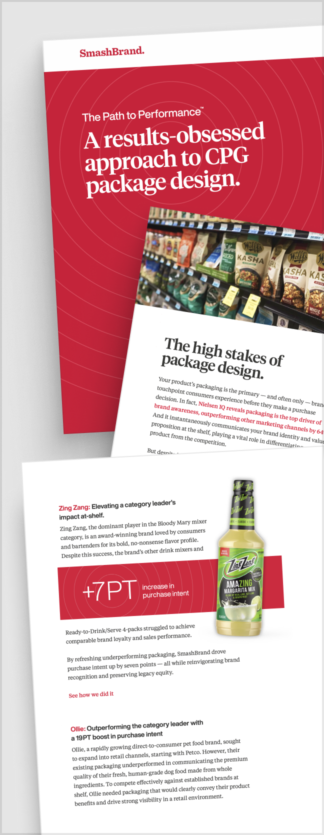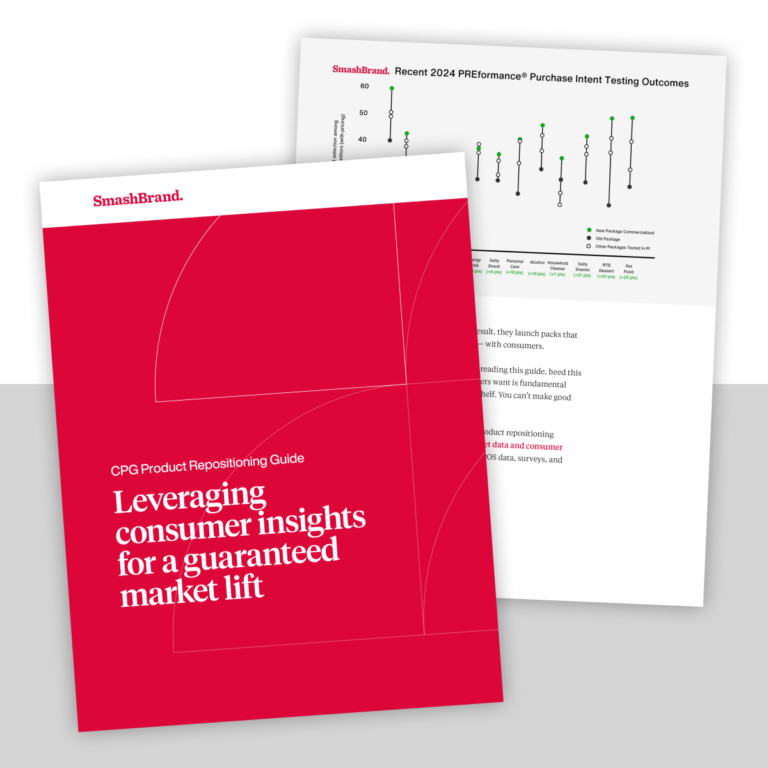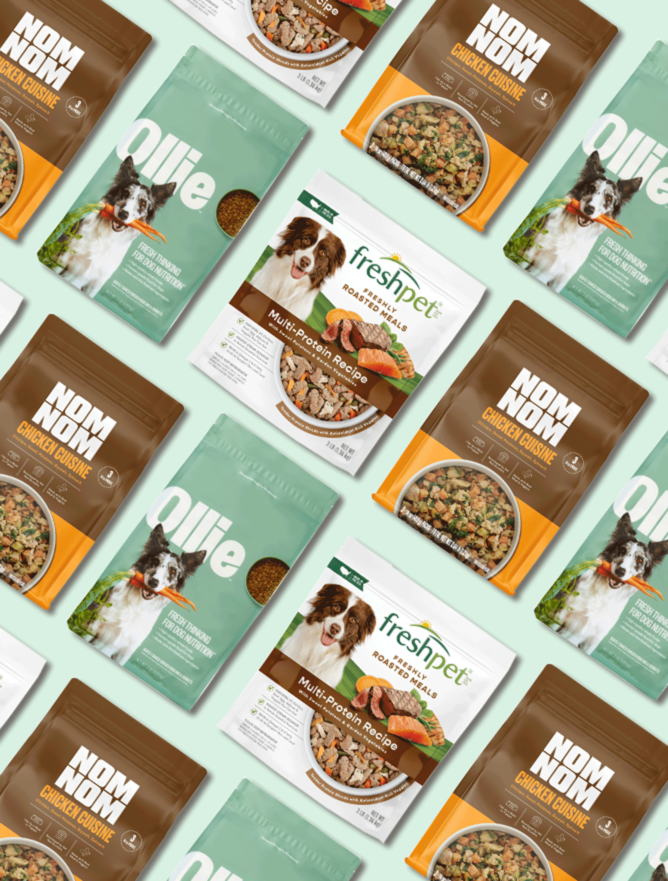Your CPG website design isn’t just a digital storefront; it’s your first, and sometimes only, chance to turn a curious visitor into a loyal customer. And yet, 94% of first impressions come down to web design, meaning a poorly executed site can sink consumer trust before they see your product. Worse? 30% of visitors leave instantly if the experience doesn’t meet their expectations.
The same principles that make packaging design successful apply here. Just like your product has seconds to win attention on a crowded shelf, your website must immediately communicate value, build trust, and drive action. Unfortunately, many CPG companies treat their websites as static brand brochures instead of high-performance sales tools.
That’s where the right approach changes everything. By integrating consumer insights, digital marketing strategies, and conversion-focused web design, brands can bridge the gap between online and in-store success. This isn’t only about aesthetics but crafting an experience that compels action and fuels sales growth.

Path to Performance™
Taking a results-obsessed approach to CPG package design.
Learn how SmashBrand’s proprietary process – rooted in scientific principles, informed by data, and validated by your target audience – takes the guesswork out of package design and delivers guaranteed results.
"*" indicates required fields
Fundamental website strategy.
A high-performing CPG website is built on data, consumer insights, and strategic execution. Every element, from brand development to user experience, must be optimized to drive conversions. The key? Consumer validation, seamless navigation, and continuous testing to ensure your site turns visitors into buyers.
Consumer-validated website design.
A bad website design kills sales. Retailers lose $2.6 billion annually because sluggish load times drive shoppers away. And here’s the kicker—75% of visitors judge a brand’s trustworthiness based on its website design alone. If your CPG company relies on opinions instead of data to shape its site, you’re leaving money on the table.
Companies must treat website design as part of their brand development process, rooted in consumer research. Just as packaging is tested before hitting the shelves, your site must be validated before launch. Heatmaps, A/B testing, and behavioral tracking reveal what’s working and what’s not. What else? A high-performing site keeps evolving with needs.
Ongoing testing fine-tunes everything, from brand strategy and user experience to graphic design and messaging. The most innovative brands—whether massive or cool nerd marketing innovators—treat their websites as dynamic assets. When data supports every decision, brand design drives actual conversions.
Brand storytelling that builds emotional attachment.
Establishing an emotional connection with consumers is pivotal for building loyalty and enhancing Customer Lifetime Value (CLV). Research indicates that compelling storytelling can increase conversion rates by 30%.
To achieve this, your website should communicate your brand’s mission, core values, unique value proposition, and key benefits in a manner that resonates with your target audience. The homepage is the ideal platform for introducing these elements. At the same time, product pages should go beyond mere descriptions to illustrate how your offerings integrate into and enhance the consumer’s daily life.
Incorporating user-generated content (UGC), such as testimonials and authentic customer experiences that support your brand’s story, significantly bolsters credibility with the target audience. Studies show that 90% of consumers find authenticity important when choosing which brands to support.
Website design and UX that converts.
A CPG website design must do more than look good. It must grab attention and guide visitors to make purchases. Data-backed tweaks can be made using tools like Google Analytics to keep users engaged. Brilliant UX and intelligent navigation, such as related posts, drive deeper interaction.
Ensuring brand consistency in website design.
A brand that looks one way in-store and another online loses credibility. Consumers expect a seamless experience across all touchpoints; brands that deliver see 20% higher revenue. What works on-pack should also work online. For example, CPG products use tested brand positioning and design to stand out on shelves, so your product pages must reinforce those elements online.
The average website conversion rate is between 2% and 5%, but top-performing brands exceed 5% by ensuring their content creation, UX design, and web development strategies. What’s more? Consistency fuels user engagement. Key selling points, benefits, and visuals must transition smoothly from packaging to product pages.
The best CPG marketing services prioritize this, ensuring every detail—from color schemes to typography—reinforces the brand and makes it instantly recognizable in digital and retail spaces.
Structuring the website for maximum conversions.
Every page on the website must guide visitors toward action, reducing friction at every step. The homepage sets the tone, immediately building trust, value, and brand recognition while directing consumers toward key products. Therefore, CPG brands must strive to incorporate storytelling and engage visitors.
Navigation should be effortless. Too many choices create decision fatigue, lowering conversions. A streamlined structure ensures visitors find what they need quickly, just as effective CPG packaging design simplifies in-store purchase decisions.
Product pages must drive action. The right content marketing strategy, backed by testing, ensures that key selling points, visuals, and CTAs are positioned for maximum add-to-cart rates.
Checkout should be seamless. Every extra step loses potential buyers. Brands that optimize their cart experience through testing see fewer drop-offs and higher sales. The goal? Make buying easy, not just browsing.
Data and AI for personalization and performance.
Understanding consumer preferences allows brands to tailor experiences that drive engagement and increase conversions. From website development to AI-powered recommendations, data ensures every interaction feels personal, turning potential customers into loyal buyers. Here’s how:
Data-driven best practices that drive sales.
First-party data is a game-changer but is often misunderstood by start-ups and underappreciated by big CPG brands. Unlike third-party sources, it gives brands direct access to consumer behavior, preferences, and engagement patterns. By leveraging this data, brands own the customer relationship, creating personalized experiences that increase retention and sales.
Refining product pages, offers, and CTAs start with insights. Analyzing how visitors navigate a site reveals what grabs attention and what causes drop-offs. Brands should adjust messaging, imagery, and CTA placement based on actual behavior, not assumptions.
Optimization never stops. Heatmaps show where users click, A/B testing compares what converts best, and analytics track performance over time. Website designs must be tested and refined continuously to improve results. Data removes the guesswork—ensuring every update moves the needle on sales.
AI, Chatbots, and Smart Assistance
Artificial intelligence is transforming how consumers interact with websites. It is making shopping faster, easier, and more personalized. For instance, AI-powered chatbots provide instant customer support, answer FAQs, and recommend products based on real-time consumer behavior, boosting engagement and conversions.
The best way to keep consumers engaged is through a personalized shopping experience. AI can analyze browsing history to suggest relevant products, optimizing the experience for each visitor. Intelligent recommendations mimic in-store assistance, guiding shoppers toward the right purchase.
Smart search and filtering eliminate friction. AI-driven search tools help consumers find exactly what they need without endless scrolling. Predictive search, filters, and intuitive navigation reduce frustration and increase sales.
SEO, Email, Social, and Other Traffic Levers
A perfect CPG website design must attract the right visitors. This requires a clear strategy to drive consistent, high-quality traffic. CPG brands must leverage various traffic channels, including SEO, email marketing, and social media integration.
Most consumers start their buying journey on Google. For instance, a pet owner may look for the best cat food online. This is the main reason why intent-based SEO is critical. Product pages must:
- Use high-value keywords aligned with consumer search intent
- feature-optimized product descriptions, highlighting the key benefits and purchase drivers.
- Include structured data, such as reviews, pricing, availability, etc.
Since most visitors won’t buy on their first visit, personalized email sequences must keep them engaged:
- Abandoned cart emails remind shoppers to complete their purchases.
- Retargeting campaigns showcase relevant products based on browsing behavior.
- Loyalty programs incentivize repeat purchases with exclusive offers.
The goal is to convert lost traffic into sales with well-timed email follow-ups. A CPG website must seamlessly connect with social platforms.
- Shoppable posts and ads drive traffic from Instagram, TikTok, and Facebook.
- Influencer and UGC content creates social proof that increases conversions.
- Social logins speed up content creation and checkout.
Leveraging brand ambassadors and influencers across the site.
Consumers trust real people more than brand messaging. Influencers, ambassadors, and real customers add authenticity that traditional marketing can’t replicate. A CPG website design that strategically integrates social validation builds trust and drives higher conversions. Shoppers relate to people who share their experiences.
Seeing an influencer or ambassador using a product creates familiarity and confidence, making them more likely to buy. Influencer content shouldn’t live only on social media—it should be woven into homepage banners, product pages, and checkout pages. Showcase testimonial videos, unboxings, and social proof to reinforce trust at every step.
A strong ambassador program turns engaged customers into brand advocates. Offering incentives for referrals, user-generated content, and exclusive perks keeps ambassadors actively promoting the brand—driving traffic and engagement back to the website.
Seamless shopping and omnichannel integration.
Shoppers don’t see a divide between online and in-store—they expect a brand to feel the same everywhere. That’s why CPG website design must seamlessly connect digital brand development with retail experiences. A strong brand development strategy ensures product messaging, visuals, and promotions remain consistent, no matter where consumers engage.
This cohesion strengthens a brand’s presence, increasing its brand development index and overall market impact. When shoppers can move effortlessly between channels—discovering a product online, finding it in-store, or completing a purchase through their preferred retailer—friction disappears, and conversions rise.
Omnichannel payment methods for frictionless checkout.
A seamless checkout experience is essential for consumer product branding and higher conversion rates. Shoppers expect payment flexibility, and offering trusted options like Amazon Pay, PayPal, Apple Pay, BNPL (Buy Now, Pay Later), and digital currencies removes friction and increases purchase completion. A complicated process leads to abandoned carts, while a streamlined checkout—optimized for product brand development—keeps buyers engaged.
Brand development in marketing isn’t just about awareness; it’s about making transactions effortless. Reducing steps, enabling auto-fill, and ensuring secure payment options build trust and drive repeat purchases. The rule is simple: the fewer clicks, the higher the conversions. Consumers buy confidently when payment feels fast and familiar, reinforcing long-term brand loyalty.
Ensuring an authentic omnichannel experience.
In the retail landscape, consumers expect seamless integration between online and physical shopping experiences. Notably, 73% of retail consumers are omnichannel shoppers, engaging across multiple platforms during their purchasing journey.
To meet these expectations, CPG websites should provide real-time information on product availability across various retail locations. Implementing “Find in Store” tools allows digital shoppers to locate products in nearby physical stores, enhancing convenience and driving foot traffic. This approach improves the customer experience and bridges the gap between online browsing and in-store purchasing.
Positioning the website as a central brand hub is crucial for supporting Direct-to-Consumer (DTC) and traditional retail growth. By offering comprehensive product information, engaging content, and seamless navigation, the website can effectively guide consumers through their purchasing decisions, whether they choose to buy online or in-store. This strategy ensures consistent brand messaging and fosters customer loyalty across all channels.
Data-driven CPG website design that guarantees performance.
At SmashBrand, we take the guesswork out of CPG website design by applying the exact data-driven brand positioning and testing methodologies that make our packaging strategies so effective. We ensure every element—from messaging to UX to conversion flow—is validated by real consumer insights. If your website isn’t driving engagement, trust, and sales, it’s time for a more innovative approach. Let’s build a winning site. Contact us today.
Subscribe to
Nice Package.
A monthly newsletter that unpacks a critical topic in the FMCG & CPG industry.
Free Resource.

CPG product repositioning guide.
Explore the five undeniable signs your CPG product needs repositioning along with strategies for leveraging consumer insights for a guaranteed market lift.
Learn More About CPG product repositioning guide.
